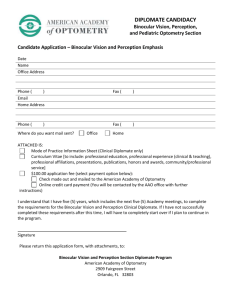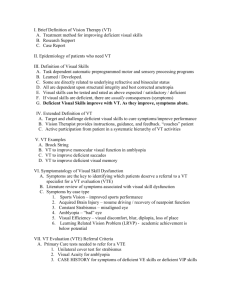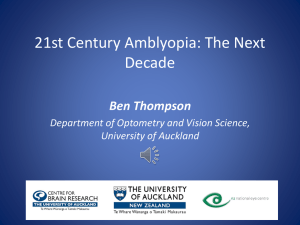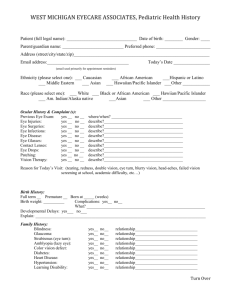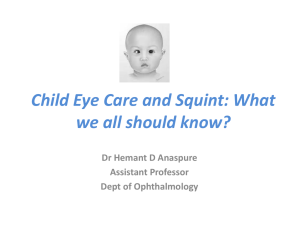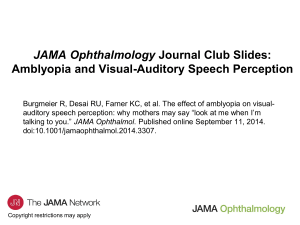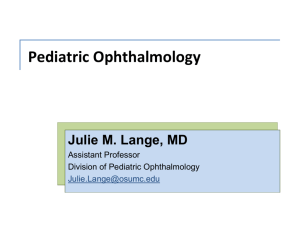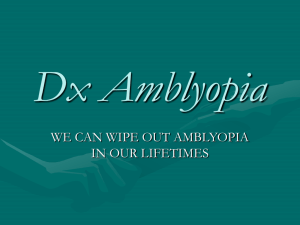outline6462 - American Academy of Optometry
advertisement
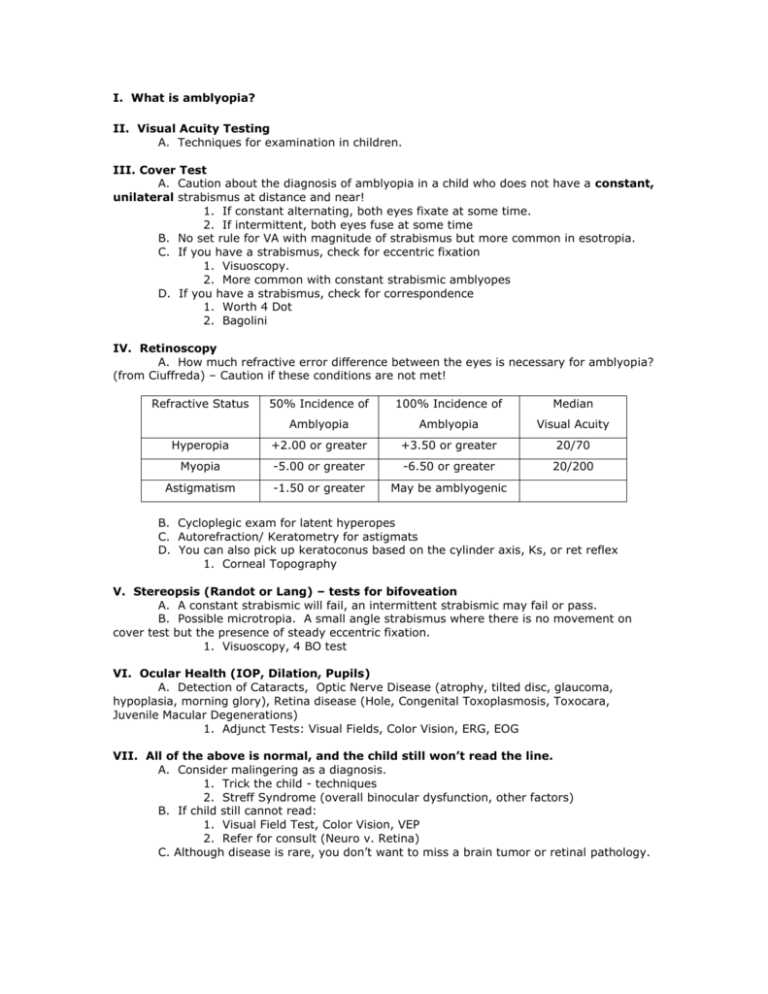
I. What is amblyopia? II. Visual Acuity Testing A. Techniques for examination in children. III. Cover Test A. Caution about the diagnosis of amblyopia in a child who does not have a constant, unilateral strabismus at distance and near! 1. If constant alternating, both eyes fixate at some time. 2. If intermittent, both eyes fuse at some time B. No set rule for VA with magnitude of strabismus but more common in esotropia. C. If you have a strabismus, check for eccentric fixation 1. Visuoscopy. 2. More common with constant strabismic amblyopes D. If you have a strabismus, check for correspondence 1. Worth 4 Dot 2. Bagolini IV. Retinoscopy A. How much refractive error difference between the eyes is necessary for amblyopia? (from Ciuffreda) – Caution if these conditions are not met! Refractive Status 50% Incidence of 100% Incidence of Median Amblyopia Amblyopia Visual Acuity Hyperopia +2.00 or greater +3.50 or greater 20/70 Myopia -5.00 or greater -6.50 or greater 20/200 Astigmatism -1.50 or greater May be amblyogenic B. Cycloplegic exam for latent hyperopes C. Autorefraction/ Keratometry for astigmats D. You can also pick up keratoconus based on the cylinder axis, Ks, or ret reflex 1. Corneal Topography V. Stereopsis (Randot or Lang) – tests for bifoveation A. A constant strabismic will fail, an intermittent strabismic may fail or pass. B. Possible microtropia. A small angle strabismus where there is no movement on cover test but the presence of steady eccentric fixation. 1. Visuoscopy, 4 BO test VI. Ocular Health (IOP, Dilation, Pupils) A. Detection of Cataracts, Optic Nerve Disease (atrophy, tilted disc, glaucoma, hypoplasia, morning glory), Retina disease (Hole, Congenital Toxoplasmosis, Toxocara, Juvenile Macular Degenerations) 1. Adjunct Tests: Visual Fields, Color Vision, ERG, EOG VII. All of the above is normal, and the child still won’t read the line. A. Consider malingering as a diagnosis. 1. Trick the child - techniques 2. Streff Syndrome (overall binocular dysfunction, other factors) B. If child still cannot read: 1. Visual Field Test, Color Vision, VEP 2. Refer for consult (Neuro v. Retina) C. Although disease is rare, you don’t want to miss a brain tumor or retinal pathology. VIII. Summary of tests to do with a child not correctable to 20/20 A. Cover Test, Retinoscopy, Cycloplegic Refraction, Autorefraction, Keratometry, Randot, Corneal Topography, Visuoscopy, 4 BO Test, Visual Field, Color, DFE, IOP, Pupils, Electrodiagnostic IX. If it is amblyopia, what does the research say to do? A. FitzGerald and Krumholtz (Optometry March 2002) 1. Amblyopes treated with Rx only, Rx and patching, Rx and therapy 2. Results: a. youngest children (<1yr can improve with Rx alone) b. 50% age 2-6 improve with patching c. 27% age 6-14 improve with patching d. 1 year follow up, 50% of all children maintained their VA e. 1 year follow up, 100% of children treated with VT maintained their VA B. Amblyopia Treatment Study (ATS) 1 (Arch Ophthalmology Mar 2002) 1. To compare patching and atropine in children younger than 7 2. Results: a. VA improvement 3.16 lines in patching, 2.84 in atropine (not statistically significant) b. 79% of patching improved by 3 or more lines, 74% of atropine group improved by 3 or more lines (not statistically significant) C. Amblyopia Treatment Study 2 (Arch Ophthalmology May 2003) 1. To compare 2 hours with 6 hours of patching 2. Results: a. 62% Success (20/32 or better, 3 or more line improvement) b. 79% improvement in VA in 2 hour groups, 76% VA improvement in 6 hour group D. Further Studies in ATS X. In my practice, what do I do? A. Management of Refractive Error in Infants, Toddlers, and Preschool Children per Elise B. Ciner 1. Emmetropization 2. Outline criteria [patient age, magnitude of refractive error (r.e.), type of r.e. (hyperopia, myopia, astigmatism) presence of behavioral or functional entities] used to determine optimal Rx; discuss full versus partial prescription 3. Follow-up: Discuss frequency and expected improvements in findings B. Home Therapy, Vision Therapy or No therapy? 1. Mohamed, David, et al (Journal American Ass Ped Oph & Strab Nov 2004) a. Risk factors for lack of vision improvement following patching or atropine penalization therapy in anisometropic amblyopia include age above 6, poor initial VA (20/200 or worse), significant astigmatism (> 1.50 D), and poor compliance 2. Patching schedule based on degree of amblyopia C. Refractive Amblyopia, going beyond Occlusion Therapy 1. Monocular Therapy techniques: fundamental techniques than can easily be implemented both at home and in the office are selected based on degree of amblyopia a. Basic gross/fine/ocular motor activities b. Basic accommodative techniques c. Basic eye hand coordination procedures 2. Anti-Suppression techniques: fundamental techniques that can easily be implemented both at home and in the office a. Bar reader b. TV trainer c. Vertical Prism Dissociation d. Mirror Superimposition 3. Binocular Therapy techniques a. Anaglyphs/polaroids b. Prisms c. Apertures d. Stereoscopes e. Home techniques (lifesaver cards, eccentric circles, brock string) D. Strabismic Amblyopia 1. Monocular Therapy techniques: key techniques that can be easily implemented both at home and in the office are selected based on degree of amblyopia a. Basic gross/fine/ocular motor activities b. Basic accommodative techniques c. Elimination of any differences in spatial localization 2. Biocular Phase: provide basic techniques than can be easily implemented both at home and in the office for patients who are candidates for this step 3. Binocular Therapy techniques a. Anaglyphs/polaroids b. Prisms c. Apertures d. Stereoscopes e. Home techniques (lifesaver cards, eccentric circles, brock string) E. Special Consideration in Deprivation Amblyopia F. Evaluating Progress and Sharing Practical Pearls 1. Follow up schedule and what to expect 2. Pre--schooler and toddler: how to adapt many of the above procedures and additional procedures designed for this age group

